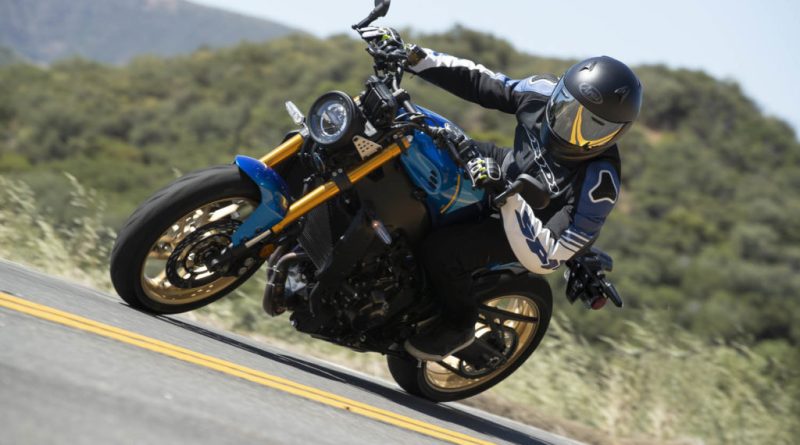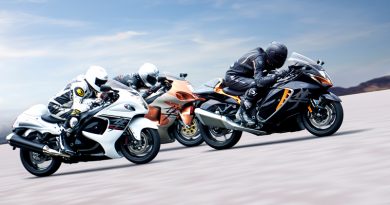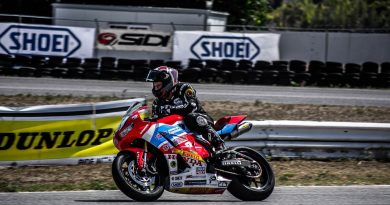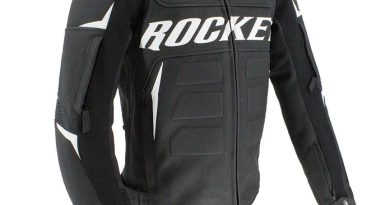2022 Yamaha XSR900 | First Ride Review
Custom cafe racers were all the rage when the Yamaha XSR900 debuted in 2015. If that wasn’t evident in the XSR’s classically shaped tank, single round headlight, and optional seat cowl, then the ‘70s-esque paint schemes certainly drove the point home. Try as it might, the XSR900’s cafe racer aspirations never quite gelled with the sloping lines of its twin-spar aluminum frame and stressed-member inline-Triple.
Trends evolve over time, though, and so has the XSR900. Updated for 2022, the neo-retro no longer aims to squeeze a square peg into a round hole. Yamaha instead starts its own trend, drawing from the brand’s rich racing history with ‘80s Grand Prix-inspired styling. A newly sculpted fuel cell, race-style side panels, and the squared-off passenger pad say as much, but the Sonauto Yamaha-era livery makes the loudest statement.
The Iwata factory matches that beauty with brawn and brains as well, featuring the same recently revised CP3 engine and 6-axis IMU that highlighted the updated 2021 MT-09. Contrary to common belief, the XSR is more than just a reskinned version of its Hyper Naked sibling. The retro roadster courts the cultured crowd with throwback threads, a tubular-steel subframe, a longer swingarm, and a Brembo radial front master cylinder. Here’s what we learned after bending the 2022 XSR900 through California’s curve-happy Highway 33 for nearly 200 miles of unfettered fun.
Firm Foundations
Yamaha’s lauded CP3 inline-Triple has always been a peach of a powerplant, but the company doesn’t rest on its laurels with the latest iteration. The larger 890cc displacement – up from 847cc – may headline the spec sheet, but Team Blue engineers did more than arm the Triple with 3mm of extra stroke. A new intake system, cylinder head, camshafts, and exhaust all contribute to the cause, and Yamaha claims 6% more torque (68.6 lb-ft at 7,000 rpm) and 11% better gas mileage (49 mpg) as a result.
In 1st and 2nd gears, throttle pick-up and roll-off still aren’t completely jolt-free, but they’re no longer lightswitch-abrupt either. By 3rd gear, the XSR fully irons out those wrinkles. The new quickshifter system aids riders in ascents to those heights too, delivering clutchless upshifts with a smooth yet positive engagement. Downshifts are no different, allowing riders to stomp down the gearbox with impunity. Whether you ride with a devil-may-care attitude or a neat character, the revised CP3 is happy to oblige.
Those adjustments may have improved the CP3’s road manners, but the torquey Triple remains as engaging as ever. Upon initial throttle crack, the rider is well aware of the power at their right wrist, and for good reason. One common complaint cast upon the previous-generation XSR900 was the snatchy throttle response. Yamaha largely smooths out those jerky mannerisms, but the Sport Heritage still possesses enough pizzaz to stir the soul.
That’s most evident with the newly updated ride modes. Yamaha drops the three-setting system (A, Standard, and B modes) of the past and sides with a simpler approach, offering four ride modes designated by number (1, 2, 3, and 4). Whether you’re cruising the boulevard or hunting apexes, the XSR instantly shifts personalities at the touch of a button.
Modes 1 through 3 pack the full punch, but each subsequent number eases the power delivery. Mode 4 not only curtails power but also provides the gentlest throttle response for soggy weather conditions. While Mode 1 unlocks the most direct power application, Mode 2 isn’t very far behind. At times, distinguishing the difference between the two settings was nearly imperceptible, but users will clearly recognize the differing powerbands among Modes 1, 3, and 4.
GEAR UP
Helmet: Arai Regent-X
Jacket: Spidi G-Warrior
Gloves: Spidi Track Warrior
Pants: Spidi J-Tracker Jeans
Boots: Dainese Persepolis Air
Fortunately, we enjoyed sunny weather while aboard the XSR, so we only taste-tested Modes 2 through 4 and mostly kept the roadster in the full power setting. Unless picking through congested urban areas or negotiating wet conditions, we expect most riders to leave the Yamaha in Mode 1 as well. The thrilling throttle response, meaty mid-range, and husky exhaust note are simply addicting and will keep owners coming back for more. The punchy Triple spreads the fun across the entire rev range too, with torque-rich tug down low and a spirited surge of power kicking in at 7,000 rpm.
Confident Cornering
Power is nothing without control, and the XSR900’s redesigned chassis harnesses all that potency to perfection. Yamaha repurposes the same die-cast aluminum frame underlying the MT-09, but couples it to the extended swingarm found on the 2021 Tracer 9 GT sport-tourer. Measuring 59mm (2.3 inches) longer than the MT-09 unit, the in-frame-mounted swingarm optimizes rigidity and stability without sacrificing much agility. The XSR doesn’t just tip-in, it dives into corners with a predictable yet urgent steering rate.
Much of that nimble nature is a result of the updated fully adjustable 41mm KYB front end and preload- and rebound-adjustable rear shock. For 2022, Yamaha increased the fork’s spring rate by 7%, boosted compression damping by 31%, and reduced rebound damping by 27%. Similar preparations help out in the rear, with the monoshock benefiting from a 21% stiffer spring rate, 35% more compression damping, and an 11% decrease in rebound damping.
The benefits of the updated suspenders are most apparent at lean. The front wheel tracks true to the rider’s initial input, but easily adapts to mid-turn steering adjustments. The fork also withstands heavy braking with aplomb but remains compliant at high lean angles. Even when cranked over on its side, mid-corner dips and undulations couldn’t compromise the XSR900’s composure. The direct and precise maneuvering also paid off in the S-curves, with the neo-retro flopping side-to-side seamlessly.
If there are any nits to pick with the XSR900’s ultra-capable chassis, it lies in the new Brembo front brake master cylinder. The upgraded component is still leagues above the previous-generation XSR’s axial-mounted unit, but the brake lever doesn’t quite deliver on the feel we’ve come to expect from the prestigious Italian brand. It provides more than enough clamping force and speed-shedding potential, but vague feedback at the lever doesn’t match the quality of Brembo’s top-tier models.
Following the initial grab, the lever’s throw becomes more vague. That stunted rate of travel makes judging exactly how much braking force to apply more challenging as speeds climb. Many riders will be more than happy with the new Brembo unit, but those dropping anchor into a tight, technical turn will also find that quality somewhat limiting . Aside from that minor niggle, however, the XSR900’s overhauled chassis largely lives up to its new GP-drawn cosmetics.
Of Man And Machine
That sporty styling extends to the new riding position as well. Compared to the outgoing XSR900, the new seat sinks the rider 22mm (0.9 inch) lower into the bike and 5mm (0.2 inch) further forward. Similarly, the handlebar grips shift 14mm (0.6 inch) fore and 35mm (1.4 inches) down for a more aggressive stance. The footpegs also drop by 7mm (0.3 inch) and nudge aft by 2mm (0.1 inch). In the cockpit, the new rider triangle feels sporty but never approaches uncomfortable. The generous tank cutouts accommodate riders well over 6-feet tall, and the rider’s upper body only slightly looms over the tank.
After hours in the saddle, I was as limber and spry as the moment I threw a leg over the XSR900’s seat. Those looking for a more committed posture can also rotate the handlebar clamps 180 degrees for 9mm (0.4 inch) of extra forward play and 4mm (0.2 inch) of rise. Adjustable footpegs should keep boot sliders from dragging with 14mm (0.6 inch) of lift and 4mm (0.2 inch) of rearward placement. We only tested ergonomics in stock form, but the adaptable touchpoints certainly position the XSR as a viable part-time track bike.
The new R1-derived electronics package supports that bid for track time with lean-sensitive traction control, slide control, lift (wheelie) control, and cornering ABS. The 6-axis IMU-based system automatically syncs slide and lift control to the selected traction-control setting (Modes 1 and 2), but users can customize the experience with the Manual Mode or turn off the rider aids altogether. Sticking to the streets, we kept the XSR900’s traction control in Mode 2 the majority of the day. Even when pushing the pace, we never tested the outer limits of the Bridgestone Battlax S22 tires to engage the traction-control system in the most sensitive setting. Still, it’s always reassuring to know that you have those safety nets, and Yamaha allows riders to fully personalize the experience via a new TFT dash.
Gone is the previous generation’s round LCD display, and the new 3.5-inch TFT makes that dash look like a relic of the past. Yamaha doesn’t go overboard with the graphics or multi-folder menu systems, though. Featuring a bar-type tachometer at the top of the layout, and with the numerical speed readout and gear indicator displayed in large font, users can quickly gather critical data at a glance. On the other hand, the limited screen size renders the drive mode, traction-control setting, time, fuel gauge, and tripmeters nearly illegible at speed. At a stop, all the data is easy to read, but many riders would welcome a larger display.
Additionally, navigating the system isn’t intuitive or self-explanatory. With the menu scroll wheel at the right handgrip, the user will need to stretch to the controls without chopping the throttle when in motion. Once inside the submenus, the spartan user interface is easy to navigate despite the scroll wheel occasionally confusing inward presses for upward rolls. While the setting menu prioritizes simplicity, the same can’t be said for the drive mode/traction-control system switches.
Located at the left handgrip, the Mode button force users to toggle between the drive mode and traction control panes before adjusting each setting with separate up/down switches. Of course, centralizing the scroll wheel and separate-function buttons on the left switchgear would have been the most user-friendly option, but with the cruise-control module taking up a large portion of the left controls, we understand Yamaha’s decision. Yes, the retro roadster has cruise control, and it works like a charm. Increasing or decreasing speed takes the system a second to apply the change, but it’s great to see such a comfort-oriented feature on a Grand Prix-influenced bike.
Dawn of a New(er) Era
Most motorcycle enthusiasts mistakenly categorized the XSR900 as a vintage-clad MT-09. Yamaha hopes to dispel those beliefs with the 2022 model. The XSR and MT may share the same 890cc CP3 Triple, die-cast aluminum frame, and R1-derived electronics system, but like fraternal twins, they also possess their own identities. If the 2022 XSR900’s outward appearance doesn’t provide enough contrast, the stiffer suspension, longer wheelbase, and Brembo radial master cylinder should convince the masses.
The new Sonauto Yamaha-informed design takes the XSR900 in a new direction, but Yamaha believes the model will remain a suitable canvas for customizers. The brand bolted on a tubular-steel subframe for that very reason, and we can’t wait to see what builders do with the new platform.
Trends come and go, but with equal measures of form and function, the 2022 Yamaha XSR900 has all the elements of a classic in the making.
2022 Yamaha XSR900 Specs
Base Price: $9,999
Price as Tested: $9,999
Website: yamahamotorsports.com
Engine Type: Liquid-cooled, DOHC, inline-Triple w/ 4 valves/cyl.
Displacement: 890cc
Bore x Stroke: 78.0 x 62.1mm
Horsepower: N/A
Torque: 68.6 lb-ft at 7,000 rpm (at the crank)
Transmission: 6-speed, cable-actuated slip/assist clutch
Final Drive: Chain
Wheelbase: 58.9 in.
Rake/Trail: 25.0 degrees/4.3 in.
Seat Height: 31.9 in.
Wet Weight: 425 lbs
Fuel Capacity: 3.7 gal.
Fuel Consumption: 49 mpg (claimed)
The post 2022 Yamaha XSR900 | First Ride Review first appeared on Rider Magazine.




